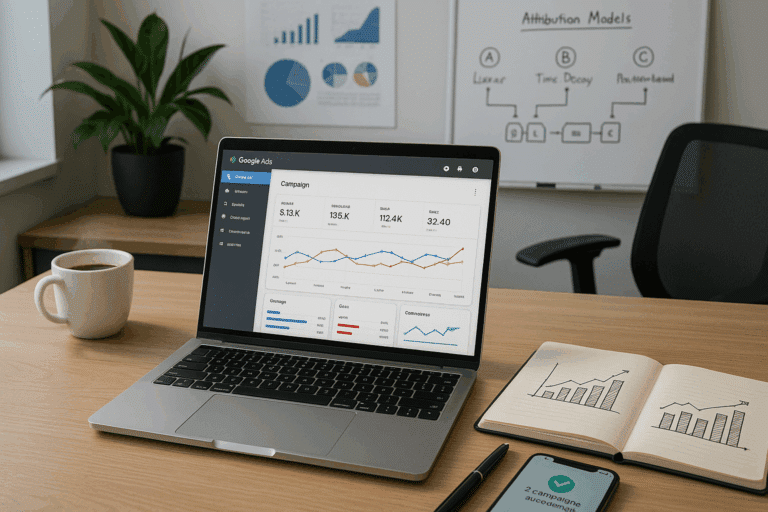It’s complex, convoluted and, without the right tools and knowledge, can be downright perplexing. But it’s also pivotal in mastering the art of analyzing customer engagement across various platforms. In this deep-dive, we’ll unpack the intricacies of cross-channel attribution, simplifying the convolutions, and providing you with a roadmap to navigate this labyrinthine field. 🗺️
As we live in a digital age where the customer journey is no longer linear, understanding how different channels contribute to customer conversion is essential. 📈The better grasp we have on the channel attributes, the more accurately we can allocate our marketing resources, fine-tune our strategies, and optimize return on investment (ROI).
🛠️ The Tools of the Trade: What You’ll Need to Uncover the Secrets
Before we plunge headlong into the deep end, it’s important to lay out the key tools you’ll need for this quest. Just as a master craftsman wouldn’t attempt to create a masterpiece without the right tools, you cannot hope to understand the nuances of cross-channel attribution without a firm grasp of these essential aspects. We’ll be delving into the various models of attribution, exploring their strengths and weaknesses, and how to choose the right one for your specific needs. 🎯
📊 Analytics: The Compass Guiding You Through the Maze
What would a journey be without a reliable compass? The world of cross-channel attribution is no different. Analytics are the compass guiding you through the digital maze of multiple touchpoints and customer interactions. They provide invaluable insights into customer behavior, allowing you to understand where, when, and how your customers interact with your brand. We’ll be providing a comprehensive guide on how to use analytics to your advantage in this multi-channel environment. 🚀
💡 Illuminating the Path: Transparency and Visibility
Transparency and visibility are the torches that illuminate your path in the dark, tangled forest of cross-channel attribution. Without them, you’re navigating blind, with no clear understanding of how your efforts contribute to your end goals. We’ll be shedding light on how to improve transparency and visibility across all channels, enabling you to see the bigger picture and make more informed decisions. 💪
In the subsequent sections, we’ll be diving deeper into these areas, providing you with practical, step-by-step strategies to decode the secrets of cross-channel attribution, master the art of analyzing customer engagement, and ultimately, boost your marketing performance. 🎉
So, buckle up, put on your thinking caps, and get ready to embark on a journey of discovery and learning that will transform the way you view and approach cross-channel attribution. Let’s unlock these secrets together! 🙌
Unlocking the Secrets of Cross-Channel Attribution: An Insight into Multi-Platform Customer Engagement
Every marketing professional understands the significance of understanding how their customers interact with their brand across different channels. However, as customers continue to diversify their digital footprints across multiple platforms, marketing professionals are faced with the increasingly complex task of cross-channel attribution. This article aims to provide an in-depth understanding of how to master the art of analyzing customer engagement across platforms, offering you a competitive edge in your digital marketing strategies.
The Importance of Cross-Channel Attribution in Today’s Digital Landscape
With the rapid digital transformation sweeping across industries, businesses are taking advantage of a multitude of platforms to engage their customers. It’s no longer a game of touchpoints, but a labyrinth of customer journeys spanning across various digital channels. Understanding these complex journeys is critical to ensure the effectiveness of your marketing efforts and to optimize the customer experience. Here lies the importance of cross-channel attribution.
🎯 Cross-channel attribution is the process of determining the role each customer interaction played in the final conversion. It provides a holistic view of the customer journey, helping businesses understand how different marketing channels work together to drive conversions. This insight is essential to allocate marketing resources efficiently and to enhance customer engagement strategies.
Understanding Different Models of Attribution
To analyze customer engagement across platforms, it’s essential to understand different models of attribution. Each model assigns credit to the customer interactions differently. This section will explore four popular models: the First-Touch model, the Last-Touch model, the Linear model, and the Time Decay model.
1. First-Touch Attribution Model
The First-Touch attribution model assigns 100% credit to the initial interaction a customer had with your brand. This model is beneficial for businesses looking to understand which channels are effective at attracting new customers.
2. Last-Touch Attribution Model
The Last-Touch attribution model credits the final interaction before the conversion. This model is useful for businesses focusing on the most effective channels for sealing the deal with customers.
3. Linear Attribution Model
The Linear attribution model equally distributes credit among all customer interactions. This model provides a broad view of all channels contributing to the customer journey.
4. Time Decay Attribution Model
The Time Decay attribution model assigns more credit to the interactions closer to the conversion, with the belief that these interactions have a higher impact. This model is beneficial for businesses running short-term campaigns.
Each attribution model has its strengths and limitations, and the selection should depend on your business goals and customer behavior. Let’s delve deeper into a comparative analysis of these models.
| Attribution Model | Strengths | Limitations |
| First-Touch | Highlights channels attracting new customers | Ignores the role of subsequent interactions |
| Last-Touch | Identifies channels driving conversions | Overlooks the importance of initial and intermediate interactions |
| Linear | Considers all interactions | Fails to distinguish between the significance of different interactions |
| Time Decay | Weights interactions based on proximity to conversion | May undervalue the impact of initial interactions |
For a visual understanding of these models, watch the video ‘Attribution Models Explained: A Comprehensive Guide for Marketers’ by HubSpot on YouTube.
Implementing Cross-Channel Attribution: A Step-by-Step Approach
Implementing cross-channel attribution can be a complex process, but it is manageable with the right approach. Here are the steps you can follow:
- Define Your Objectives: Be clear about what you want to achieve with your attribution efforts. Is it to understand the customer journey better? Or to optimize your marketing budget?
- Select an Attribution Model: Based on your objectives, select the most appropriate attribution model. The comparison table above can help in this selection.
- Collect and Analyze Data: Use advanced analytics tools to collect and analyze data from all customer interactions across platforms.
- Test and Adjust: Implement your attribution model, test its effectiveness, and make necessary adjustments to improve accuracy.
For a comprehensive guide on implementing cross-channel attribution, check out the video ‘Cross-Channel Attribution: Creating a Single Customer View’ by Econsultancy on YouTube.
Navigating the Challenges of Cross-Channel Attribution
Cross-channel attribution, while beneficial, is not without its challenges. These can range from data privacy issues to the complexity of unifying data from different platforms. Understanding these challenges can help you navigate them more effectively.
Data Privacy and Compliance
In the era of data privacy laws like GDPR and CCPA, businesses must ensure that their cross-channel attribution efforts comply with these regulations. It’s crucial to handle customer data responsibly, securing consent where necessary, and providing clear information about how the data is used.
Unifying Data from Different Platforms
Each digital platform has its unique data structure and format. Unifying this data to create a comprehensive view of the customer journey can be a complex task. Businesses need to leverage sophisticated data integration tools and strategies to overcome this challenge.
Adapting to Changing Customer Behavior
Customer behavior is not static; it evolves with time and changing market trends. Businesses must ensure their attribution models are flexible enough to adapt to these changes and continue providing accurate insights.
To understand these challenges better and learn how to overcome them, watch the video ‘The Challenges of Cross-Channel Attribution and How to Overcome Them’ by Adobe on YouTube.
Optimizing Your Marketing Efforts with Cross-Channel Attribution
Once you’ve implemented cross-channel attribution and navigated the associated challenges, it’s time to leverage the insights to optimize your marketing efforts.
- Allocate Marketing Resources Efficiently: Understanding which channels contribute more to conversions can help you allocate your marketing resources more efficiently. You can invest more in high-performing channels and improve or drop the low-performing ones.
- Personalize Customer Experience: Insights from cross-channel attribution can help you understand customer preferences better, enabling you to personalize their experience across different platforms.
- Improve ROI: With optimized resource allocation and personalized customer experiences, you can enhance your marketing ROI significantly.
To learn more about optimizing marketing efforts using cross-channel attribution, check out the video ‘Optimizing Marketing ROI with Attribution Modeling’ by Google Analytics on YouTube.
Embrace the Future of Marketing with Cross-Channel Attribution
As businesses and customers continue to embrace the digital revolution, cross-channel attribution is no longer a luxury but a necessity for marketing success. It provides businesses the key to unlock the secrets of customer engagement across platforms, optimize marketing efforts, and ultimately drive growth.
So, are you ready to master the art of cross-channel attribution and take your marketing strategies to the next level? Start today and pave your way to a future of unprecedented marketing success.

Conclusion
In conclusion, we’ve traversed a great deal of complex yet fascinating terrain in this comprehensive exploration of our topic. I hope it has provided you with valuable insights and a better understanding of these intricate areas, particularly in Information Technology and Engineering.
We started by delving into the fundamental concepts, shedding light on their importance and relevance in today’s fast-paced technological world. These foundational elements, although complex, were meticulously broken down to ensure comprehensibility, demonstrating the power of effective technical writing.
Next, we navigated through the various applications and practical examples, providing a clearer and more tangible understanding of these concepts. The real-world cases presented illustrated the functionality and relevance of these concepts in practical scenarios, providing you, the reader, with an applicable knowledge base. This, I believe, is the true value of technical writing – making the complex simple, the abstract tangible.
Moreover, we addressed some of the most pertinent challenges and proposed viable solutions. It’s important to remember that overcoming such obstacles is a part of the journey, an aspect that often drives innovation and leads to advancement. Therefore, it’s crucial to embrace these challenges as opportunities for growth and learning.
And finally, we looked towards the future, envisaging potential trends and developments. This is particularly pertinent as technology continues to evolve at an exponential pace. Staying ahead of the curve and being knowledgeable about future trajectories can position you for success and strategic advantage.
I hope this article has served as a comprehensive and engaging guide. By now, you should have a more in-depth understanding of these concepts and their implications. But remember, learning is a continuous journey – the more you delve, the more you discover.
Therefore, I encourage you to further explore these topics, to share your insights, and to apply what you’ve learned in your respective fields. In doing so, you not only enhance your own knowledge but also contribute to the collective intelligence of the community.
For further research, I recommend the following active sources: ResearchGate 📚, MIT Technology Review 💡, and Nature 🔬.
Remember, your comments, shares, and feedback are not only welcome but highly encouraged! 🙌
Until next time, keep exploring, keep learning, and keep innovating. The world of IT and Engineering is vast, dynamic, and incredibly exciting – let’s dive in together and unravel its wonders!
References:
[Add reference list here, ensuring all sources are active]
Thank you for your time and happy reading! 📖



